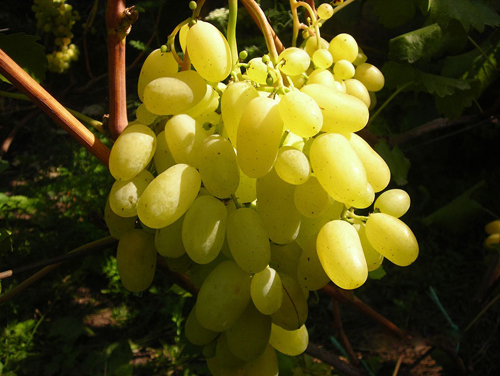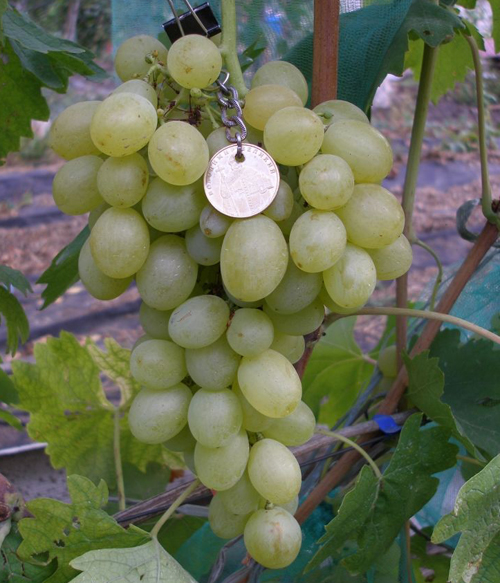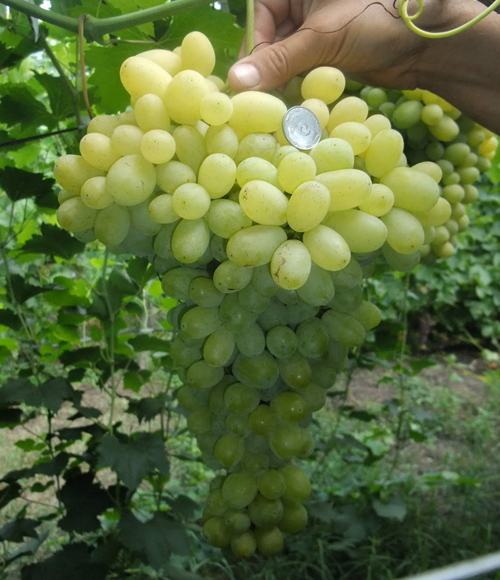Laura grape variety (Flora)
Laura (aka Flora) is a stunningly successful white table grape variety. He comes from Ukraine, bred in the Odessa Institute of Viticulture and Winemaking. V.E. Tairov. A wide team of authors worked on the selection of the novelty, including: Meleshko L.F., Dokuchaeva E.N., Dylyk A.P., Storozhuk E.M., Chebanenko E.P., Bankovskaya M.G., Yarmak E .D. and Staseva M.I. And there was something to work on. The new form was the result of a complex hybridization, when at first Muscat de Saint-Valier was pollinated with a mixture of pollen from Muscat of Hamburg and Husain, and then the resulting hybrid was used as a mother form already paired with Queen Tairovskaya.

The derived hybrid form turned out to be very attractive both in terms of external data and in terms of taste. Over the years of variety testing, it fell in love with many amateur winegrowers, becoming widespread with the name Laura. And in 2011, it was already officially registered in the state register of plant varieties of Ukraine, being renamed Flora for some unknown reason. In Russia, the variety has not yet been zoned, although it is very popular at the amateur level.
The grapes are distinguished by beautiful, large-sized bunches and berries, excellent taste, very early ripening of the crop, high productivity and adaptability to various climatic conditions.
Agrobiological characteristics
The bushes are medium-sized. The leaves are medium-sized, five-lobed, slightly dissected, green or dark green, reticulate-wrinkled on top, covered with light cobweb pubescence from below. The lateral notches are open, barely outlined. The petiole notch is open, with a sharp bottom. The denticles at the edges of the leaf blade are small, triangular with a wide base. Laura flowers with a functionally female type of flowering, which determines the need for the presence of pollinators next to the variety.

The bunches of grapes are very large, weighing about one kilogram or more, up to 2.5 kg. Conical in shape with "wings", medium density. The stem of the crest is long, in the berries it is of medium length, with a strong attachment to the bunch. The berries match the bunches - very large, weighing 8-10 grams or more, oval-oblong, up to 40 mm long and about 30 mm in diameter. The pulp is dense, fleshy, with a crunch characteristic of oriental varieties. The taste is bright, memorable, balanced, with a distinct nutmeg aroma when fully ripe. The skin is thin, of a beautiful salad-milk color with a white waxy bloom, and in the sun with a slight tan. There are few seeds - one or two, they are quite large in size, however, due to the outstanding size of the berries themselves and the easy separation from the pulp, they do not spoil the impressions of Laura's tasting at all. A ripe crop, provided there is sufficient protection from wasps, can continue to hang from the bushes. You should not do this only in damp years, when cracking of berries is possible due to high soil moisture.
The crop is intended for fresh consumption, has an excellent presentation, enjoys well-deserved attention and is in great demand among buyers. Due to the high density of the pulp, the grapes are suitable for long-distance transportation and are kept quite well provided that they are carefully picked, there is no damage to the skin and a protective wax layer on the surface of the berries is preserved.

The variety is ultra-early ripe, the harvest reaches removable maturity in 110-115 days after bud break. A characteristic feature of Laura is the amicable ripening of aligned, almost identical in shape and size bunches, which also adds marketability to the crop. The sum of active temperatures required for ripening is 2400-2500 ° C, and therefore the grapes have time to ripen even in the middle lane. Productivity, subject to good care and high-quality pollination, is very high - 120-130 kg / ha. On a bush, it is quite a feasible task to grow up to 20 kilograms of harvest without signs of overload.The frost resistance of the plant is increased (-21-23 ° C). Dissolving buds are high - 80%. Fruitful shoots from 60 to 80%. On average, from 0.9 to 1.3 bunches are laid for each shoot. Sugar content reaches 20 g / 100 cm³, acidity ranges from 5-8 g / dm³. The ratio of sugar and acid in the taste is harmonious.
Agrotechnical features
To form a high-quality bountiful harvest, Laura, along with any other variety, needs to perform both generally accepted agrotechnical measures in the vineyard, and take into account its specific features. The latter primarily includes the functionally female type of flowering inherent in this variety of grapes. This means that the flowers are not able to pollinate themselves with their own pollen, and for the formation of the ovary, pollinators with bisexual flowers growing in the vicinity are needed, or artificial pollination by hand.

Fortunately, Laura has shown good results in cross-pollination with other varieties, which makes it unnecessary to resort to tedious artificial pollination manipulations. At the same time, the treatment of inflorescences with a growth stimulator with gibberellin will be quite appropriate and expedient. Such a manipulation will not only improve the fertilization of flowers, but also have a positive effect on the growth of berries, which, as a result, will become larger in size and acquire an attractive oblong shape. In addition, often this procedure allows you to get seedless berries, which will also have a positive effect on the tasting characteristics of the grapes.
Like all high-yielding varieties, Laura needs strict rationing of the load of the bushes. If you leave too many bunches on the plant, then there is a high probability of a sharp decrease in their weight and size, delay in ripening and its unevenness, when even one bunch will contain both unripe and overripe berries. Otherwise, if a strong bush is underload, the clusters will grow very large, which to some extent compensates for the lack of brushes. However, at the end of the growing season, the plant can re-grow, which will negatively affect its winter hardiness.
The optimal load of an adult grape bush will be 40-50 healthy eyes that have wintered, with a length of pruning of fruit arrows for 6-9 buds. Formation methods should be chosen depending on the climatic conditions and the possibilities of the variety for overwintering in your region without shelter for the winter. If there is such an opportunity, you should choose standard forms of bush management, in cold climates, pay attention to covering fan forms.
On the fruitful shoots of Laura, it is recommended to leave one bunch at a time, or pinch off the lower part of them in the early stages of their growth, if for some reason the extra brushes have not been removed.
The variety has varying degrees of resistance to diseases: susceptible to powdery mildew, sufficiently resistant to mildew and practically not affected by gray rot. In accordance with this specificity, it is necessary to build a strategy for the protection of grapes.
Despite the lack of a predisposition to cracking berries, it will not be superfluous to monitor the water regime of the soil, and, if possible, regulate it, preventing excessive drying out.
If you follow all these simple recommendations carefully and on time, then there is no doubt that Laura will thank you with a high yield of amazingly attractive and tasty grapes.








